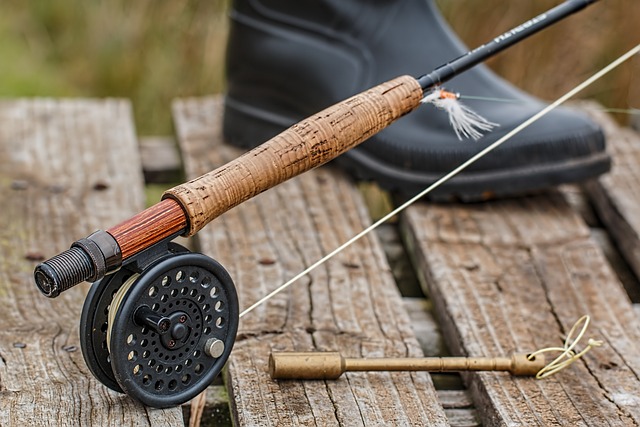Fly fishing is a popular pastime for anglers all over the world. To be successful at fly fishing, it’s important to have the right equipment, including a good fly rod. One popular option is the 5wt fly rod. But what exactly is a 5wt fly rod and what is it best suited for?
A 5wt fly rod is good for fly fishing scenarios that involve catching small to medium-sized fish such as trout, panfish, and smallmouth bass in small streams, creeks, and ponds. It is also suitable for dry fly fishing, and nymphing, and is a versatile tool for beginners and experienced anglers alike.
But this is not the whole picture. In this post, I will explore the ins and outs to master the 5wt fly rod, including its definition, materials used, and cost considerations. I will also discuss the different situations and types of fish that a 5wt fly rod is well-suited for, as well as its advantages and disadvantages.
Finally, I will provide tips for choosing the right 5wt fly rod for your needs and skill level. By the end of this post, you will have a clear understanding of what a 5wt fly rod is good for and how to choose the right one for your fly-fishing adventures.
What is a 5wt fly rod?
A 5wt fly rod is a type of fly rod that is designed to handle a specific weight of a fly line, which is also known as the line weight. The “5wt” refers to the weight of the fly line that the rod is designed to cast. A 5wt fly rod is typically around 8-9 feet in length and made of materials such as graphite, fiberglass, or bamboo.
It is designed to be lightweight and flexible, with a fast or medium-fast action that allows for accurate casting and control of the line. The 5wt fly rod is a versatile tool that is well-suited for a range of fly fishing techniques, including dry fly fishing, nymphing, and small stream fishing. It is a popular choice for beginners and experienced anglers alike due to its ease of use and versatility.
What is a 5wt fly rod good for?
A 5wt fly rod is a versatile tool that is suitable for a range of fly fishing scenarios. Here are some of the situations and types of fish that a 5wt fly rod is well-suited for:
- Trout fishing: A 5wt fly rod is ideal for fishing for trout, which are typically found in smaller streams and rivers. The flexibility of the rod allows for delicate presentations of dry flies and nymphs, while the fast or medium-fast action provides the necessary power to cast larger flies.
- Small stream fishing: A 5wt fly rod is perfect for fishing in small streams and creeks where a longer rod would be cumbersome. The lightweight and maneuverable nature of the rod makes it easier to navigate through brush and overhanging trees.
- Dry fly fishing: Dry fly fishing involves using a lightweight, buoyant fly that imitates an insect floating on the water’s surface. A 5wt fly rod is well-suited for this type of fishing, as it allows for delicate presentations of the fly without spooking the fish.
- Nymphing: Nymphing involves fishing with a weighted fly that imitates a nymph, or immature insect, beneath the water’s surface. A 5wt fly rod is suitable for nymphing as it has the necessary power to cast heavier flies and the flexibility to detect subtle strikes.
- Panfish and smallmouth bass fishing: A 5wt fly rod can also be used for catching panfish and smallmouth bass in ponds and small lakes. The rod’s sensitivity allows for detecting strikes from smaller fish, while its power is sufficient to handle larger fish.
In summary, a 5wt fly rod is a versatile tool that is suitable for trout fishing, small stream fishing, dry fly fishing, nymphing, and panfish and smallmouth bass fishing. Its lightweight, maneuverable nature and flexibility make it ideal for these scenarios.
Advantages of using a 5wt fly rod
There are several advantages to using a 5wt fly rod for fly fishing. Here are five of the main advantages:
- Versatility: One of the primary advantages of a 5wt fly rod is its versatility. It can be used for a range of fly fishing techniques, making it a great all-around rod for beginners and experienced anglers alike. Whether you’re fishing for trout, panfish, or smallmouth bass, a 5wt fly rod is suitable for the job.
- Ease of use for beginners: A 5wt fly rod is a great option for beginners who are just starting to learn how to fly fish. It’s lightweight and easy to handle, which makes it easier for beginners to cast accurately and control the line.
- Cost-effective: A 5wt fly rod is generally less expensive than heavier or longer fly rods, making it a cost-effective option for anglers who are just starting out or who are on a budget.
- Good for small streams and ponds: A 5wt fly rod is ideal for fishing in small streams and ponds, where a longer or heavier rod would be impractical. The rod’s maneuverability makes it easier to navigate through brush and overhanging trees, while its sensitivity allows for detecting strikes from smaller fish.
- Useful for catching small to medium-sized fish: A 5wt fly rod is suitable for catching small to medium-sized fish, such as trout, panfish, and smallmouth bass. The rod’s power is sufficient to handle these types of fish, while its flexibility allows for delicate presentations of dry flies and nymphs.
Overall, the versatility, ease of use, cost-effectiveness, and suitability for small streams and ponds make a 5wt fly rod a great option for many fly fishing scenarios.
Disadvantages of using a 5wt fly rod
While there are many advantages to using a 5wt fly rod for fly fishing, there are also some disadvantages to consider. Here are some of the main disadvantages:
- Limited range and accuracy: A 5wt fly rod has a limited range compared to heavier or longer fly rods. It also has less accuracy at longer distances, which can make it more difficult to reach fish in larger bodies of water.
- Unsuitable for larger fish or strong currents: A 5wt fly rod may not have enough power to handle larger fish or strong currents. Trying to catch a larger fish with a 5wt fly rod can put too much strain on the rod and lead to damage or breakage.
- Not suitable for windy conditions: Windy conditions can make the casting with a 5wt fly rod more difficult, as the lightweight nature of the rod can cause it to be affected by the wind. In these conditions, a heavier or longer fly rod may be more appropriate.
- May not be appropriate for certain fly fishing techniques: While a 5wt fly rod is versatile and suitable for many fly fishing techniques, it may not be the best choice for certain techniques, such as saltwater fishing or fishing for larger game fish.
While a 5wt fly rod is a great option for many fly fishing scenarios, it does have some limitations. Its limited range and accuracy, unsuitability for larger fish or strong currents, susceptibility to windy conditions, and unsuitability for certain fly fishing techniques are all factors to consider when deciding whether or not to use a 5wt fly rod.
How to choose the right 5wt fly rod
Choosing the right 5wt fly rod for your needs and skill level can make a big difference in your fly fishing experience. Here are 5 factors to consider when choosing a 5wt fly rod:
- Consider the species of fish you will be targeting: The species of fish you will be targeting will impact the length, power, and action of the rod you choose. For example, if you’re targeting larger trout, you may want a slightly heavier 5wt rod with faster action.
- Consider the type of water you will be fishing in: The type of water you will be fishing in will also impact the length, power, and action of the rod you choose. If you’re fishing in smaller streams and ponds, a shorter and more flexible 5wt rod may be more appropriate.
- Consider your own level of experience and skill: Your own level of experience and skill will also impact the type of 5wt fly rod you choose. If you’re a beginner, a more forgiving and easy-to-use 5wt rod may be best, while more experienced anglers may prefer a faster and more sensitive rod.
- Consider the brand and quality of the fly rod: The brand and quality of the fly rod will also impact your choice. Higher-quality fly rods tend to be more expensive, but they also tend to offer better performance and durability.
- Try before you buy: Finally, it’s always a good idea to try out a few different 5wt fly rods before making a purchase. This will allow you to get a feel for the different lengths, powers, and actions of the rods and choose the one that feels most comfortable and suitable for your needs.
Conclusion
In conclusion, a 5wt fly rod is a versatile tool that is suitable for a range of fly fishing scenarios, including trout fishing, small stream fishing, dry fly fishing, nymphing, and panfish and smallmouth bass fishing.
Its lightweight, maneuverable nature and flexibility make it ideal for these scenarios, and it is also a great option for beginners due to its ease of use. However, a 5wt fly rod also has some limitations, including its limited range and accuracy, unsuitability for larger fish or strong currents, susceptibility to windy conditions, and unsuitability for certain fly fishing techniques.
When choosing a 5wt fly rod, it’s important to consider the species of fish you will be targeting, the type of water you will be fishing in, your own level of experience and skill, the brand and quality of the fly rod, and to try out a few different options before making a purchase. By choosing the right 5wt fly rod for your needs, you can enhance your fly fishing experience and increase your chances of success on the water.









